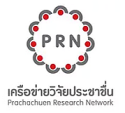บุพปัจจัยคุณภาพชีวิตการทำงานของบุคลากรในกรมราชทัณฑ์ในจังหวัดปทุมธานี
คำสำคัญ:
การวัดผลเชิงดุลยภาพ , การบริหารทรัพยากรมนุษย์, คุณภาพชีวิตการทำงานบทคัดย่อ
การวิจัยนี้มีวัตถุประสงค์เพื่อศึกษาการวัดผลเชิงดุลยภาพ การบริหารจัดการทรัพยากรบุคลากร และคุณภาพชีวิตในการทำงานของบุคลากรสังกัดกรมราชทัณฑ์ในจังหวัดปทุมธานี รวมถึงปัจจัยที่มีผลต่อคุณภาพชีวิตการทำงาน การวิจัยใช้ระเบียบวิธีวิจัยเชิงปริมาณ เก็บข้อมูลด้วยแบบสอบถามจากกลุ่มตัวอย่าง 480 คน วิเคราะห์ข้อมูลด้วยสถิติเชิงพรรณนาและการวิเคราะห์โมเดลสมการโครงสร้างด้วยวิธี PLS-SEM โดยพิจารณาค่าสัมประสิทธิ์เส้นทาง ค่าสัมประสิทธิ์การตัดสินใจ และขนาดของผลกระทบ
ผลการวิจัยพบว่า การวัดผลเชิงดุลยภาพมีอิทธิพลอย่างมีนัยสำคัญต่อคุณภาพชีวิตการทำงานทั้งทางตรง (0.602) และทางอ้อม (0.0285) ผ่านการบริหารจัดการทรัพยากรมนุษย์ รวมเป็นอิทธิพลรวม 0.887 (p < 0.001, f² = 0.72) การบริหารจัดการทรัพยากรมนุษย์มีอิทธิพลทางตรงต่อคุณภาพชีวิตการทำงาน (0.328, p < 0.001, f² = 0.215) และการวัดผลเชิงดุลยภาพมีอิทธิพลทางตรงต่อการบริหารจัดการทรัพยากรมนุษย์ (0.866, f² = 3.003, p < 0.001) สามารถอธิบายความแปรปรวนของคุณภาพชีวิตการทำงานได้ 81.3% (R² = 0.813) ปัจจัยสำคัญที่มีผลต่อคุณภาพชีวิตการทำงาน ได้แก่ 1) การวัดผลเชิงดุลยภาพเป็นปัจจัยที่มีอิทธิพลมากที่สุด 2) การบริหารจัดการทรัพยากรมนุษย์ และ 3) ปฏิสัมพันธ์ระหว่างทั้งสองปัจจัย องค์ความรู้ใหม่คือ การค้นพบความสัมพันธ์เชิงบวกระหว่างการวัดผลเชิงดุลยภาพและคุณภาพชีวิตการทำงานในบริบทของหน่วยงานราชการไทย ซึ่งแตกต่างจากการศึกษาในภาคเอกชนที่มักพบว่าปัจจัยด้านค่าตอบแทนมีความสำคัญสูงสุด
เอกสารอ้างอิง
กรมราชทัณฑ์. (2564). ภารกิจและอำนาจหน้าที่ของกรมราชทัณฑ์. กระทรวงยุติธรรม. http://www.correct.go.th/?page_id=12255
Armstrong, M. (2006). A handbook of human resource management practice (10th ed.). Kogan Page.
Biron, M., Farndale, E., & Paauwe, J. (2011). Performance management effectiveness: Lessons from world-leading firms. The International Journal of Human Resource Management, 22(6), 1294-1311. https://doi.org/10.1080/09585192.2011.559100
Bowling, N. A., Eschleman, K. J., & Wang, Q. (2010). A meta‐analytic examination of the relationship between job satisfaction and subjective well‐being. Journal of Occupational and Organizational Psychology, 83(4), 915-934. https://doi.org/10.1348/096317909X478557
Bozeman, B., & Rainey, H. (1998). Organizational Rules and the “Bureaucratic Personality”. American Journal of Political Science, 42(1), 163. https://doi.org/10.2307/2991751
Bryson, J. M., Crosby, B. C., & Bloomberg, L. (2014). Public value governance: Moving beyond traditional public administration and the new public management. Public Administration Review, 74(4), 445-456. https://doi.org/10.1111/puar.12238
Chumg, H. F., Seaton, J., Cooke, L., & Ding, W. Y. (2016). Factors affecting employees' knowledge-sharing behaviour in the virtual organisation from the perspectives of well-being and organisational behaviour. Computers in Human Behavior, 64, 432-448. https://doi.org/10.1016/j.chb.2016.07.011
Coccia, M. (2009). Research performance and bureaucracy within public research labs. Scientometrics, 79, 93-107. https://doi.org/10.1007/s11192-009-0406-2
Cohen, J. (1988). Statistical power analysis for the behavioral sciences (2nd ed.). Lawrence Erlbaum Associates.
Efron, B., & Tibshirani, R. J. (1993). An introduction to the bootstrap. Chapman and Hall/CRC.
Fornell, C., & Larcker, D. F. (1981). Evaluating structural equation models with unobservable variables and measurement error. Journal of Marketing Research, 18(1), 39-50. https://doi.org/10.2307/3151312
Gerrish, E. (2016). The impact of performance management on performance in public organizations: A meta‐analysis. Public Administration Review, 76(1), 48-66. https://doi.org/10.1111/puar.12433
Hair, J. F., Hult, G. T. M., Ringle, C. M., & Sarstedt, M. (2017). A primer on partial least squares structural equation modeling (PLS-SEM) (2nd ed.). Sage.
Hair, J. F., Risher, J. J., Sarstedt, M., & Ringle, C. M. (2019). When to use and how to report the results of PLS-SEM. European Business Review, 31(1), 2-24. https://doi.org/10.1108/EBR-11-2018-0203
Henseler, J., Ringle, C. M., & Sarstedt, M. (2015). A new criterion for assessing discriminant validity in variance-based structural equation modeling. Journal of the Academy of Marketing Science, 43(1), 115-135. https://doi.org/10.1007/s11747-014-0403-8
Idrus, A., Armanu, A., & Rohman, F. (2015). The Role of Bureaucratic Leadership, Organizational Culture, and Organizational Commitment on Organizational Performance. European Journal of Business and Management, 7, 8-16.
Jiang, K., Lepak, D. P., Hu, J., & Baer, J. C. (2012). How does human resource management influence organizational outcomes? A meta-analytic investigation of mediating mechanisms. Academy of Management Journal, 55(6), 1264-1294. https://doi.org/10.5465/amj.2011.0088
Kallinikos, J. (2004). The Social Foundations of the Bureaucratic Order. Organization, 11, 13-36. https://doi.org/10.1177/1350508404039657
Kaplan, R. S., & Norton, D. P. (1996). The balanced scorecard: Translating strategy into action. Harvard Business School Press.
Khoreva, V., Vaiman, V., & Van Zalk, M. (2017). Talent management practice effectiveness: Investigating employee perspective. Employee Relations, 39(1), 19-33. https://doi.org/10.1108/ER-01-2016-0005
Kooij, D. T., Jansen, P. G., Dikkers, J. S., & De Lange, A. H. (2010). The influence of age on the associations between HR practices and both affective commitment and job satisfaction: A meta‐analysis. Journal of Organizational Behavior, 31(8), 1111-1136. https://doi.org/10.1002/job.666
Lambert, E. G., Hogan, N. L., & Griffin, M. L. (2017). Research note: A career-stage analysis of correctional staff outcomes. The Prison Journal, 97(4), 411-430. https://doi.org/10.1177/0032885517710910
Morgado, S., Leal, S., & Ruivo, P. (2021). A systematic literature review of the quality of working life and employee outcomes. In International Conference on Management Technology and Tourism Social Value Creation (pp.64-78).
Nunnally, J. C., & Bernstein, I. H. (1994). Psychometric theory (3rd ed.). McGraw-Hill.
Obeidat, B. Y., Masa'deh, R., & Abdallah, A. B. (2014). The relationships among human resource management practices, organizational commitment, and knowledge management processes: A structural equation modeling approach. International Journal of Business and Management, 9(3), 9-26. https://doi.org/10.5539/ijbm.v9n3p9
Pandey, S. K., & Moynihan, D. (2005). Bureaucratic Red Tape and Organizational Performance: Testing the Moderating Role of Culture and Political Support. La Follette School Working, 2005-2026. https://dx.doi.org/10.2139/ssrn.867124
Pandey, S., Coursey, D. H., & Moynihan, D. (2007). Organizational Effectiveness and Bureaucratic Red Tape: A Multimethod Study. Public Performance & Management Review, 30, 398-425. https://doi.org/10.2753/PMR1530-9576300305
Paramita, A., & Salamah, U. (2017). Organizational Culture as a Determinant Factor of Government Institution Reputation. IGCC, 1, 904-922.
Punyaratabandhu-Bhakdi, S. (1983). Individual Values, Organizational Structure, and the Problem of Performance: Thailand as a Case Study. Public Administration Review, 43, 510-519.
Rosca, I., & Moldoveanu, G. (2010). The Tandem Culture - Organizational Bureaucracy in Public Sector. Theoretical and Applied Economics, 6(547), 7-16.
Sirgy, M. J., & Lee, D. J. (2018). Work-life balance: An integrative review. Applied Research in Quality of Life, 13(1), 229-254. https://doi.org/10.1007/s11482-017-9509-8
Valmohammadi, C., & Roshanzamir, S. (2015). The guidelines of improvement: Relations among organizational culture, TQM and performance. International Journal of Production Economics, 164, 167-178. https://doi.org/10.1016/j.ijpe.2014.12.028
Walton, R. E. (1973). Quality of working life: What is it?. Sloan Management Review, 15(1), 11-21.
Zheng, C., Molineux, J., Mirshekary, S., & Scarparo, S. (2015). Developing individual and organisational work-life balance strategies to improve employee health and wellbeing. Employee Relations, 37(3), 354-379. https://doi.org/10.1108/ER-10-2013-0142
ดาวน์โหลด
เผยแพร่แล้ว
รูปแบบการอ้างอิง
ฉบับ
ประเภทบทความ
สัญญาอนุญาต
ลิขสิทธิ์ (c) 2025 วารสารวิชาการสังคมศาสตร์เครือข่ายวิจัยประชาชื่น

อนุญาตภายใต้เงื่อนไข Creative Commons Attribution-NonCommercial-NoDerivatives 4.0 International License.
บทความที่ได้รับการตีพิมพ์เป็นลิขสิทธิ์ของวารสารวิชาการสังคมศาสตร์เครือข่ายวิจัยประชาชื่น







